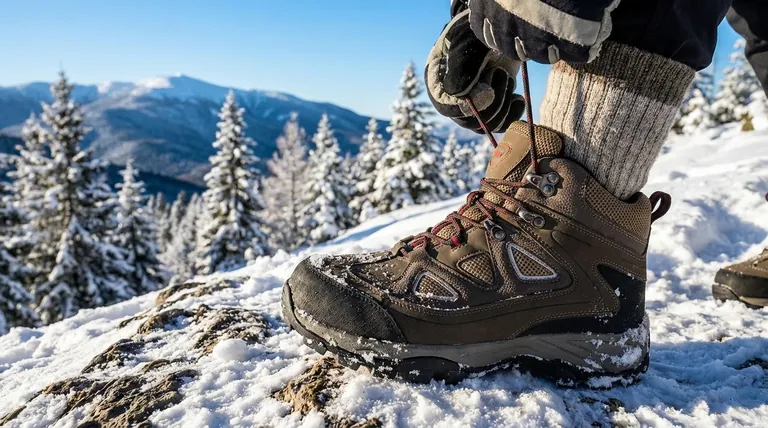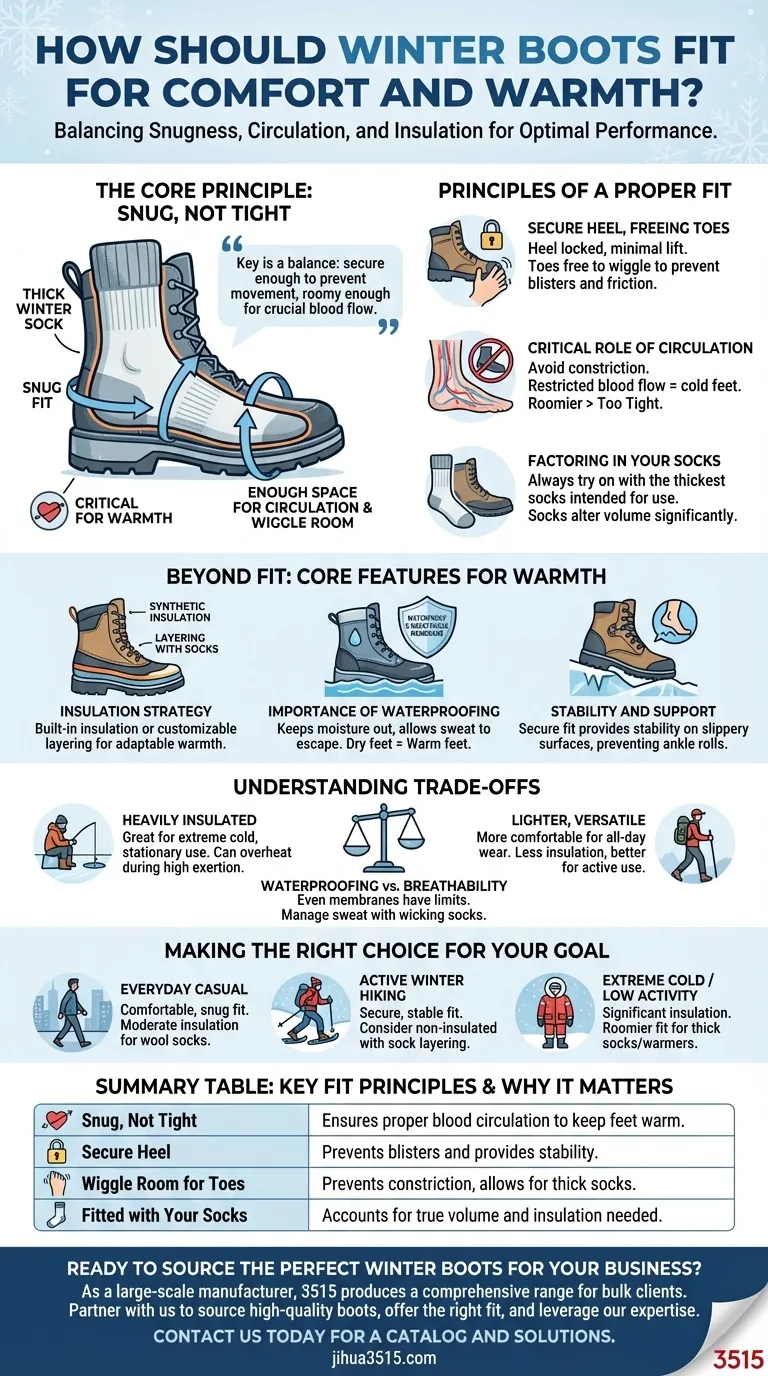To ensure both warmth and comfort, your winter boots should fit snugly but not tightly. The ideal fit leaves enough space to accommodate thick winter socks without constricting your foot, which is critical for maintaining the blood circulation necessary to keep your feet warm.
The core principle of a proper winter boot fit is achieving a balance: your foot must be secure enough to prevent movement and blisters, yet have enough room to allow for crucial blood flow and the insulating layer of air provided by your socks.

The Principles of a Proper Fit
A winter boot that feels perfect with a thin sock will likely become a cold trap in freezing temperatures. The fit must account for both the boot's features and how you will wear it.
Securing the Heel, Freeing the Toes
Your heel should feel comfortably locked into the back of the boot with minimal to no lift as you walk. However, you should still be able to freely wiggle your toes. This combination prevents the friction that causes blisters while ensuring the front of your foot isn't cramped.
The Critical Role of Circulation
The single most common mistake is choosing a boot that is too tight. A constricted fit restricts blood flow, and without proper circulation, your feet will get cold regardless of how much insulation the boot has. A slightly roomier fit is always better than one that is too snug.
Factoring in Your Socks
Always try on winter boots while wearing the thickest pair of socks you intend to use. Socks significantly alter the volume inside the boot, and fitting for your bare foot will lead to a dangerously tight fit in real-world conditions.
Beyond Fit: Core Features for Warmth
While fit is the foundation, several key features work together to protect your feet from the cold.
Insulation Strategy
Many winter boots feature built-in synthetic insulation for warmth. However, some experienced hikers prefer non-insulated waterproof boots, allowing them to customize their warmth level by layering with thicker or thinner socks depending on the activity and temperature.
The Importance of Waterproofing
Your feet must stay dry to stay warm. A quality winter boot should have a waterproof and breathable membrane. This keeps moisture from snow and slush out while allowing sweat to escape, preventing the dampness that rapidly chills your feet.
Stability and Support
Winter conditions mean walking on uneven and slippery surfaces. A boot that fits securely provides the necessary stability and support to prevent ankle rolls and ensure confident footing. Taller boots offer the added benefit of keeping more of your lower leg warm and protected.
Understanding the Trade-offs
Choosing the right winter boot involves balancing competing priorities. Understanding these compromises is key to making an informed decision.
Insulation vs. Versatility
Heavily insulated boots are excellent for stationary activities in extreme cold, like ice fishing or spectating sports. However, they can cause your feet to overheat and sweat during high-exertion activities like hiking, which ultimately makes you colder.
Waterproofing vs. Breathability
Even the most advanced waterproof membranes have limits. In warmer conditions or during intense activity, sweat can build up faster than the membrane can vent it. This highlights the importance of moisture-wicking socks to help manage sweat from the inside.
Weight vs. Comfort
Lighter boots are generally more comfortable for all-day wear and reduce fatigue. However, heavier, more robust boots often provide superior stability, durability, and protection in harsh, rugged terrain.
Making the Right Choice for Your Goal
Select your boot based on its primary purpose to ensure the fit and features align with your needs.
- If your primary focus is everyday casual wear: Prioritize a comfortable, snug fit with moderate insulation and enough room for a quality wool sock.
- If your primary focus is active winter hiking or snowshoeing: Opt for a secure, stable fit to prevent heel lift, and consider a non-insulated boot to precisely manage warmth through sock layering.
- If your primary focus is extreme cold or low-activity use: Choose a boot with significant insulation and a slightly roomier fit to accommodate thick socks and toe warmers without compromising circulation.
Ultimately, the right fit is the one that allows you to forget about your feet and focus on your winter activity.
Summary Table:
| Key Fit Principle | Why It Matters |
|---|---|
| Snug, Not Tight | Ensures proper blood circulation to keep feet warm. |
| Secure Heel | Prevents blisters and provides stability on slippery surfaces. |
| Wiggle Room for Toes | Prevents constriction and allows for thick socks. |
| Fitted with Your Socks | Accounts for the true volume and insulation needed for winter. |
Ready to Find the Perfect Winter Boots for Your Business?
As a large-scale manufacturer, 3515 produces a comprehensive range of winter footwear for distributors, brand owners, and bulk clients. Our production capabilities encompass all types of insulated, waterproof, and performance winter boots designed with the precise fit and features your customers need.
Partner with us to:
- Source high-quality boots built for comfort, warmth, and durability.
- Offer your customers the right fit for every winter activity, from casual wear to extreme conditions.
- Leverage our expertise in manufacturing to meet your specific volume and design requirements.
Let's discuss your winter footwear needs. Contact our team today to request a catalog and learn more about our manufacturing solutions.
Visual Guide

Related Products
- Safety Footwear Wholesale Manufacturer for Custom OEM/ODM Production
- Premium Insulated Safety Boots and Shoes for Wholesale & Bulk Orders
- Durable Waterproof Rain Boots | Custom Manufacturer for Wholesale & Brands
- Durable Rubber Sole Outdoor Shoes Wholesale & Custom Manufacturing
- Wholesale Safety Footwear Manufacturer for Bulk & Custom OEM Orders
People Also Ask
- Is safety-toe as good as steel toe? Choose the Right Protection for Your Job
- How long can you wear safety boots? The Lifespan is Determined by Wear, Not Time
- What cultural and environmental considerations are tied to wearing shoes indoors? Balance Hygiene, Tradition, and Foot Health
- What are the differences between steel toe, composite toe, and alloy toe Wellington boots? Choose the Right Safety Toe for Your Job
- Is it normal to wear shoes in the house? A Guide to Hygiene, Comfort & Culture



















